The Enduring Influence of Marx’s Masterpiece
No book has done more than Capital to explain the way the world works.
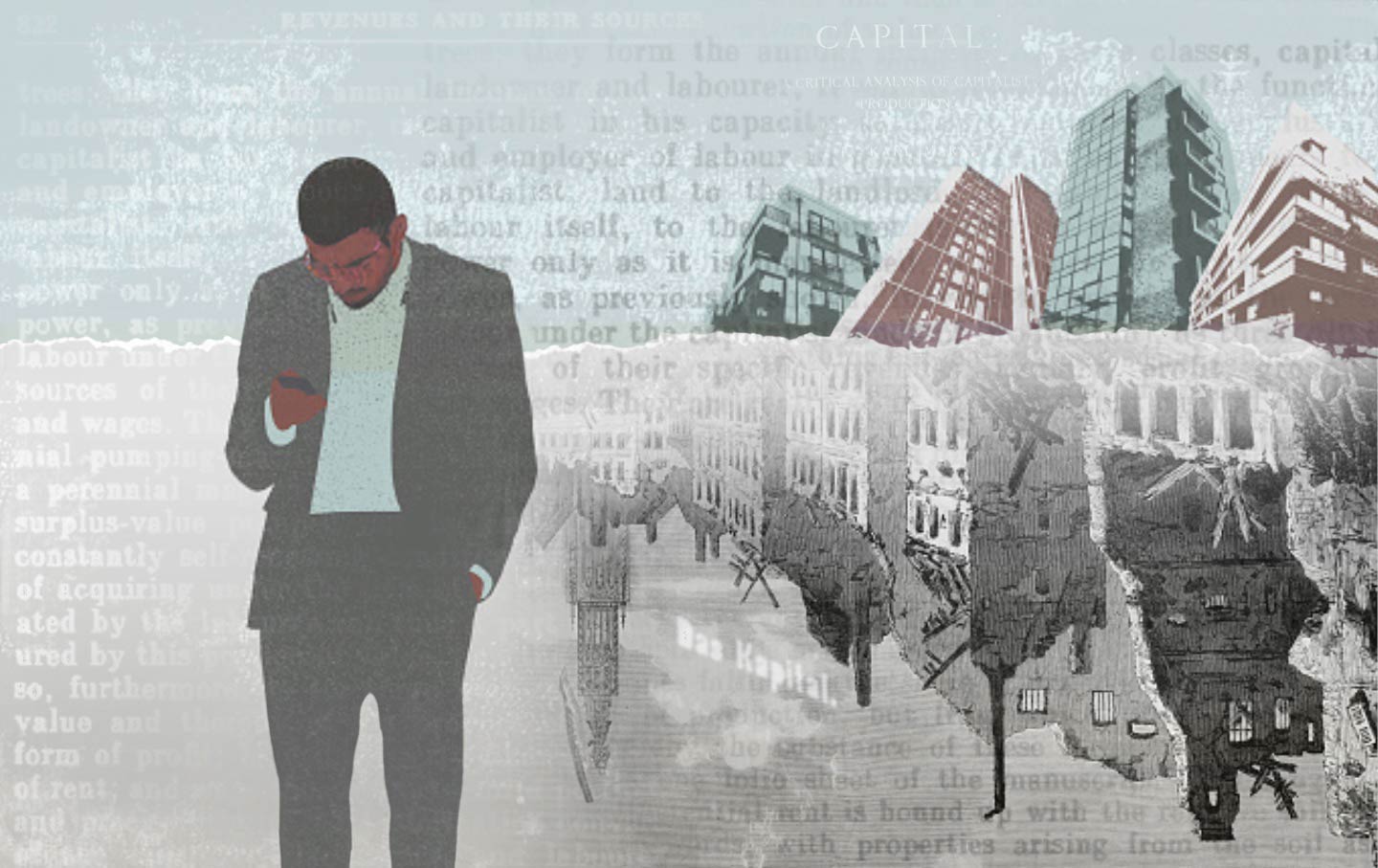
Only a few centuries old, capitalism’s unprecedented mode of producing for human needs and generating wealth shapes present and future conditions of earthly existence more pervasively and profoundly than anything else humans have made. It affects the entirety of the planet’s surface and crafts both possibilities and challenges for all life upon it. It arrays 8 billion homo sapiens across a wildly uneven spectrum of opulence, comfort, poverty, and desperation. It contours all social relations and subjectivities, from practices of work and leisure to arrangements of kinship, intimacy, and loneliness. In addition to class, it constructs and mobilizes race and gender in continuously changing yet persistently exploitable ways. It powers technological revolutions and scatters the discarded remains of past ones everywhere on earth and in orbits circling it. It birthed the Anthropocene—the epoch in which human and “natural” histories are now permanently and dynamically entwined—and within it, the Great Acceleration: the short half-century in which fossil fuel use intensified so radically as to inaugurate what scientists term the Sixth Mass Extinction. And it incited the development of finance, artificial intelligence, and other practices animated by digital technologies that bode ever more intense and paradoxical ways to both serve and dominate the species that invented them.
Mainstream social science identifies capitalism as an economic system based in markets organized by free competition and spurred by the profit motive. But where is the power to make and destroy worlds in this formulation, to draw everything into its orbit, to permeate and transform every physical and psychic cell of earthly life? For Marx, the thinness and superficiality of the mainstream account not only shrouds capital’s power and plunder but ignores its conditions of existence, the social relations constituting and constituted by it, the protean orders it creates, transforms, destroys, abandons. Indeed, what Marx’s work forever challenged was not only capitalism’s exploitative nature and commodifying effects, for which he is readily known, but the reduction of economics to markets and thus to a domain of knowledge and practice imagined to be independent of social relations, histories, laws, family forms, politics, policing, religion, language, representation, and psyche. In its place, Marx developed an understanding of political economy as the distinctive mode through which we build entire worlds through our singular cooperative powers—transforming nature, elaborating divisions of labor and organizations of ownership, producing wealth, creating ways of life, institutions, social forms, subjects, and subjectivities. The discipline of economics, then and now, slices markets out of these worlds and studies them as if they were an independent field of conduct and knowledge.
For Marx, understanding capitalism means grasping all of its conditions, requirements, drives, mechanisms, dynamics, contradictions, crises, iterations, and above all its world-making and world-destroying capacities, its life and death drives: Even at its birth, capital exhibited this power as it wrenched labor from the land to fill factories and cities that it would later empty in an era of dispersed global production. As it developed, it would transform everything humans needed first into a source of exchange-value and then, with financialization, into a source of speculative value. Producing new ways of life at every turn, its drives to extract, commodify, and monetize every living and fossilized element on earth also laid waste to whole regions, regimes, nonhuman species, and landscapes.
Marx knew that this unprecedented order of production and destruction, extraction and exploitation was not easy to see or understand. This was especially so because it took place under the sign of freedom—free markets, free humans, and the free circulation of labor, capital, and commodities. Grasping capital’s power and reach thus necessitated broadening and deepening the scope of political economy, departing from economists’ calculative economic frameworks for historical, philosophical, social-theoretical, and even theological ones. It requires leaving what he called the “noisy sphere” of the market not only to enter the factory (posted with its sign, “No admittance except on business”) to see where wealth was produced, but to adopt a framework that accounts for the perversity and illusion of markets coming to stand for the whole. It requires understanding why capital’s complex and distributed workings are less visible to the eye than previous modes of political economy, how its freedoms obscure the drives and effects that make it the greatest system of domination ever made or inhabited by humans. All of these requirements are counterintuitive to those who equate capitalism with markets, where buyers and sellers, supply and demand, money and price, are the only things elemental and visible.
What was necessary to capture and analyze capital’s vastness, power, complexity, and opacity, then, was not merely a new description of it but “a critique of political economy,” Capital’s subtitle. Political economy itself has a dual venue and meaning for Marx: It refers to practical arrangements, to practices of knowledge and, as we shall see, to their complex cogeneration and entwining. Critique of the practical arrangements entailed discerning both how capitalism worked and did not work, its engines and drives, its structural crises, and its wide ramifications and effects beyond markets. Critique of knowledge practices related to political economy included both its popular and erudite forms—the language of capitalists, the language of scholars, and the language of those in between such as that of left polemicists and journalists. Critique of erudite knowledge in turn comprised scope, method, and conceptualization as well as content. Marx’s task in Capital was enormous.
That said, critique was something Marx had honed since his college days, though as Paul North notes, it took a new form in his late-life study of political economy. Marx knew what the archives were and how to handle them. He knew how to look beneath and through the concepts that political economists deployed to discover their premises or predicates, how to artfully invert (or “evert,” as North suggests) received formulations and antimonies, how to reveal the many-sidedness of seemingly simple or unified elements of political economy. And he knew how to discover relations and processes, histories, violence, and capacities in seemingly inert things, indeed how to make things “speak” such that they could appear as agentic elements in a system.
Marx had also argued since his youth that bourgeois representations, both popular and erudite, bore an intimate if perverse relationship to the world they emanated from and depicted and that this relationship was part of what had to be investigated in order to surface power and the illusions protecting it. Critique thus always entailed a triple move—critique of thought or representation, critique of actual arrangements and dynamics of power, and a critical or symptomatic reading of the relation between the intellectual and the practical, or, to use Marx’s terms, ideal and material life. Only this triple move could reveal bourgeois political economy and political theory as harboring crucial features of what it represented in distorted form, features that included the distortion itself. The classical political economists were therefore invaluable building blocks for Marx’s thinking. On the one hand, they developed an early if incomplete labor theory of value, a version that could not answer the most fundamental questions about capital (What is the constitutive relation between labor and capital? Where does profit come from? What makes the entire system move, expand, falter, and crash?). On the other hand, this very incompleteness pointed to the self-obscuring manner in which capital appeared in the world and provided clues about the kind of critical theory required to reveal its true nature.
Marx’s great work is widely understood to center on a core revelation: Capital is the coagulated effect of the labor it exploits, and capitalism incessantly ramifies this exploitation in time and space. In his famous turn of phrase, “Capital is dead labor that acts like a vampire: It comes to life when it drinks living labor, and the more living labor it drinks, the more it comes to life.” Capital’s requirements of increased labor exploitation over time—exploiting more workers and exploiting them more intensively— and in space—ever expanding markets for its commodities—constitute the life and death drives of capitalism, drives that are as insatiable as they are unsustainable. They reduce the masses to impoverishment, concentrate wealth among the few, and pile up crises that spell the system’s eventual collapse, overthrow, or, as we have later learned, reinventions through the social state, the debt state, neoliberalism, financialization, and the asset-enhancing and de-risking state. Since growth is essential for what Marx called the “realization of surplus-value” or profit, capitalist development becomes an almighty shredder of all life forms and practices, including its own recent ones. From small shops, family farms, and cities to gigantic industries, rain forests, and even states, everything capital makes or needs it will eventually also destroy. In Marx’s summary, “Capitalist production thus advances…only by damaging the very founts of all wealth: the earth and the worker.”
If capital’s basic life and death drives—global searches for cheap labor and materials; unregulated, untaxed production and investment; and new markets for its commodities, which together eventually generate systemic crises—are the essential story, why did Marx not tell it simply and straightforwardly, especially given his ambition for a working-class readership? Why instead does Capital comprise hundreds of pages of complex formulations, difficult abstractions, and long theoretical detours into everything from the nature of the commodity to the nature of money to the nature of value? And why so much engagement with classical theorists of economics and politics? Why a dense scholarly treatise on capitalism rather than a bold account of its productive and destructive powers?
We might begin to answer this way. Capital is not only a critique of political economy but a philosophy of political economy, and more precisely an account of why philosophy is required for an understanding of capital. It is a philosophical critique of unphilosophical approaches to political economy, those not alert to its many elements beyond markets (including law, politics, militias, and police but also language, mystification, and theology), those that do not interrogate political economy’s fundamentals (labor, capital, value, money, the state) to discover their genesis, nature, and constitutive relations with one another, and those inapt to examining the relation between capital’s surfaces and depths.
Capital’s philosophical orientation is present in its opening lines, where Marx introduces an order of appearance that he will have to disassemble and analyze to get at the true nature of his object. Marx begins:
The wealth of societies dominated by the capitalist mode of production appears in the form of an “enormous accumulation of commodities.” The individual commodity appears as the elementary form of that wealth. Hence our investigation begins by analyzing the commodity.
The verb “appears” suggests that capital is bound up with representation. But bound up in what way? More than a cover to be pulled off so that the truth might be revealed, capital’s many distracting and seductive semiotic surfaces are a vital part of what capital is and does. Neither separate nor precisely false, intrinsic to the system yet mystifying it, capital’s surfaces are simultaneously essential, dissimulating, and clues to understanding its structure and dynamics. In Marx’s hands, these appearances and their unreliable relation to the truth become a broad heuristic for grasping capital as processes and mediations, transmutations and transmogrifications, and as depletable and enhanceable—anything but an obdurate thing. They also signal that even as it covers and homogenizes the world, and promulgates its freedoms as universal, capital exercises distinct practices of division and separation. It divides different spheres of economic activity (production and exchange) and between social and political realms of power and identity (civil society and state). It separates humans from their labor (as labor-power) and from the product of their labor (as commodities). It divides labor itself ever more finely and will eventually divide processes of production so complexly and extensively as to generate what we today call global supply chains. It divides finance from production, management from ownership, ownership from control, and more. Above all, it divides owners from producers. Paradoxically, these divisions and separations underlie capital’s capacity to create historically unprecedented concentrations of wealth.
Together, these mediations, transmutations, divisions, and separations make every single-sided analysis of capital a mirage—precisely the mirage that bourgeois political theory and political economy orbit around. Yet, Marx will insist, the mirages are vital in leading us to the truth ordering the whole. Capital’s presentation as an “immense heap of commodities” is not a red herring:Rather, it is part of what must be explained to understand its true elementary form, namely the labor process coagulated in commodities, which does not appear on their surfaces. The same is true of the capitalist marketplace more generally, where buyer and seller (including of labor-power itself) both appear “free” because the conditions producing them are invisible there. In short, understanding capital requires grasping its generation of mystifying appearances as endemic to its production process.
Marx foretells this need in his own preface to the first German edition of Capital. Preparing the reader for the difficult conceptual work ahead, he writes: “All beginnings are difficult” holds for every branch of science and scholarship. The first chapter—and especially the section that contains my analysis of the commodity—will therefore be the hardest to understand. The value-form, which in its fully developed shape is the money-form, has little content and is actually quite simple. Yet for more than 2,000 years, the human mind has failed to comprehend it, while much more complex forms that have much more content have been analyzed with at least some degree of success. Why? A whole body is easier to study than its individual cells. Furthermore, microscopes and chemical reagents are of no help to us when we analyze economic forms. Our power of abstraction must do the work of both things, for in bourgeois society, the commodity-form of labor products, or the value-form of commodities, is the economic cell-form. To the untrained eye, analyzing these forms appears to be an exercise in splitting hairs. And in fact it is such an exercise—in the same way that microscopic anatomy is.
Stare as we might at the misery of the toiling masses juxtaposed with the opulent lives of capital’s owners, only through what Marx calls our power of abstraction can we understand why this condition exists, what produces and perpetuates it. This peculiar and distinctly human power of abstraction, Marx says, parallels microscopes and chemical reagents for its revelatory capacity, yet it is purely intellectual, a feat of mind rather than one dependent upon external instruments. Moreover, abstraction does not magnify or separate components, as laboratory instruments do, but develops registers other than manifest ones for critically representing processes constituting the object. And unlike social scientific modeling, it entails linguistic inventions to produce formulations that invert and theorize the relation of the concrete (illusory) and the abstract (real) to get at the truth of the whole. With abstraction, then, Marx does not aim simply to get underneath capital’s self-representations—its “enormous accumulation of commodities” or “relations among commodities which are actually relations among men.” Rather, abstraction reveals capital’s concrete elements and dynamics, their historical and social genesis and their constitutive relations with each other. This, for Marx, is the work of critical theory, and it is crucial to understand Capital as such a theory and to appreciate political economy as requiring it. Put differently, Marx places the philosophical question of what is true about a philosophical object at the foundation of his critical theory of capital. Bringing philosophy into the material sphere to explain capital and criticize previous accounts of it alters both crude understandings of materialism and the meaning and practice of philosophy such that it becomes critical theory.
Of course Capital is not only theory—its splendid pages include several kinds of histories, economic formulas, social descriptions, literary riffs, polemics, jokes, and more. However, Marx features capital as a relentlessly theoretical subject, and one whose theoretical requirements are novel and challenging. This is not only because capital involves complex representations and dissimulations but because it is a system of intricate social relations and powers that flow beneath its surfaces. With our eyes, we see factories, laborers, capitalists, bushels of wheat, or money. We see capitalists and workers, wealth and poverty, comfort and toil. We do not see what has brought any of this into being, the relations among these things, or the premises, conditions, dynamics, conflicts, and crises of the entire system. We do not see the production of “free labor” (labor stripped of its capacity to sustain itself except by working for a wage); we do not see socially necessary and surplus labor-time, exploitation, or alienation. We do not see histories or social relations comprising capital and labor and bringing them into being as classes. We do not see the “dead labor” coagulated in every commodity. We do not see the drives that make capital voraciously and ceaselessly expand. We do not see the histories, spatialities, connections, and effects that together produce the totality of what capitalism is and does.
To understand capital, then, we need to see otherwise. This is the work of theory, a term that comes to us from the Greek theoria—meaning to see or watch from an intellectual or actual distance—in order to see more or other than one sees in the midst of things. Theoretical work is not ancillary or optional for understanding political economy but fundamental precisely because from money to markets, profit to productivity, nothing reveals its constitutive histories or processes, the nature of its relation with other components and to its dissimulating appearances. Every ele- ment is objective, yet none expresses its origin, place in the system, constitution, or power through its facticity.
Capital requires theory in part because it is a master separator; its power, efficiency, and even protection from its enemies derive from all that it divides and pulls apart. Again, it separates workers from the means of production (through the enclosure movements), from their products (through alienation), and from one another (through free labor, extensively divided). It separates the sphere of production from the spheres of exchange and consumption. It separates capital from land, finance from industry, state from civil society, town from country. The mediations that emanate from and secure these separations systematically invert their relations of generation and dependency, from positing capital as a priori, the source of all wealth, to positing the state rather than civil society as the locus of freedom and equality.
Capital also requires theory because it simultaneously massifies and disperses: It socializes the productive process and implicitly collectivizes labor, yet it produces and depends upon a distinctly atomized form of freedom, one in which the worker is free to dispense of their own labor-power and is thrown on their own means (wages) for survival. As proletarianization emancipates workers from overt control by feudal or slave masters, and bourgeois revolutions enfranchise them as citizens with rights, they are not only freed from servitude and formal political subjection but emancipated from all forms of dependence and protection. The free circulation of capital and labor and the emergence of commodity-based survival breaks up forms of association that provisioned life through interdependence, producing atomized consumer society in its stead. This “freedom,” however, is installed within a machinery of capitalist domination, one that evades control even by the wealthy and powerful. The atomization makes possible the domination; the domination produces the atomization; “freedom” is essential to their coproduction. Such an operation of power is historically novel and, as with the many separations and divisions in political economy, is what theory brings to light.
As we learn to look behind the dramatis personae of power that distract even the most politically savvy (and who litter Marx’s work so that he can reveal their puppet strings), we finally see political economy for what it is: namely, modes of production featuring relations and forces that animate history and that organize social and political orders dominating us until and unless we develop a new mode featuring collective ownership and control. Put differently, on Marx’s account, capital’s opaque surfaces—where reifications and fetishisms are in play—signal an order of political economy that has ripened into a totality, one comprising these unseeable relations and forces whose effects are unprecedented and only graspable theoretically. This is the complex truth into which Marx inducts his readers in the book’s first half. It is a truth that features the disjunction between how capital appears and how it actually works as a disjunction produced by capital itself and as an explanation for the failures of previous political economists. In Marx’s own words:
As accepted modes of thought, forms of appearance are reproduced spontaneously and without mediation, while their hidden underpinnings have to be discovered by science and scholarship. Classical political economy has come close to stumbling onto the true state of affairs, but it hasn’t consciously formulated what it has found—and won’t, as long as it remains in its bourgeois skin.
And the practical revolutionary promise? Apprehension of capitalism’s predicates and drives, relations and circulations, points to what must be overcome: exploitation, alienation, living to work rather than working to live, and ubiquitous domination by a machinery under no one’s control. Concretely, there is connection across divided spheres and separated activities, cooperation hovering just below the atomization, and the great vulnerability of capital to organized resistance from labor, its source of sustenance. The workers unite not merely to redistribute wealth but to suture estranged spheres of activity and reconnect life with work, workers with one another, production with need, humans with the powers they have unleashed in the world. At this point, what was mystified becomes transparent, and theory no longer has to struggle with so much:
The religious mirroring of the real world won’t vanish until the workaday world’s practical relations become consistently transparent, rational relations among people and between people and nature. The form of the social life-process—i.e., the material production process—will not shed its foggy shroud of mystery until it becomes the product of freely associated people, planned and controlled by them.
The brilliance and enduring relevance of Marx’s anatomy of capitalism rest in his formulating of its object as at once singularly theoretical and material, as human made yet beyond human control, with more power to set the conditions for all planetary life than anything the species has ever unleashed.
The world we inhabit today is unimaginable without capital but also without Capital. Both forever changed worldly imaginaries, as they changed Marx’s own. Both also set permanent intellectual tasks before us, including that of developing and revising Marx’s thought to take the measure of capital’s complex iterations and transmogrifications in the century and a half since he wrote.
To name but the most obvious of these: There is the rise (and fall) of the regulatory and social state, and of the middle and professional classes. There is the growth of the corporation and, with it, transformations in the nature of ownership, management, and stratifications among workers exceeding anything Marx imagined. There is the rise of finance, with its radical transformations in the production and concentration of wealth, in class formation and reproduction, and in the relation of private and public, capital and states. There is the emergence of thousands of autonomous economic zones that “perforate” the conventional economic and political fabric of nation-states. There is globally disseminated production and, with it, new iterations of the racial stratifications accompanying capital accumulation since its inception. There is the (always partial) commodification of care work, which, as it moves from household to market, remakes gender, kinship, and family forms. There is the supplementation of commodity production by the service, information, and platform economies, and the transformations of capital and labor each entails. And there is what Marx termed “the free gift of nature” giving way to widespread recognition of planetary finitude and fragility, a recognition incited by catastrophic climate change and species extinction chains.
Popular
“swipe left below to view more authors”Swipe →Do these and other developments, as well as capital’s proven ability to remake itself in relation to various regimes, technologies, political demands, and opportunities render Marx’s great work anachronistic? If, for example, the “labor theory of value” no longer explains the production of all wealth, or the crisis of the planet today rivals human misery and injustice as an indictment of capitalism, should we still read the book?
In his introduction to a new translation of Capital, Paul North reminds us that the term “capital” descends from the Latin capitalis and Middle English caput, both of which meant “head” and were linked to owned wealth (originally in the form of heads of cattle). In the framework of the classical political economists whom Marx takes to task, capital/head and labor/body are radically separated and autonomous from each other. This separation and imagined autonomy are replicated in the capitalist factory in the relation between boss (head) and workers (bodies), and again in the separation of production from exchange— laboring bodies produce the value of commodities but in the market, Marx says, they have value “only in relation to each other”—like talking heads. Heads cut off from bodies is also the framework through which Marx reflects on the history of the division of labor, “which only becomes truly such from the moment when a division of material and mental labor appears.” And it is how Marx theorizes the relation of the bourgeois state to civil society: Identifying the former with idealism in both senses of the word and the latter with material life, the material-ideal relation in this realm reiterates and consecrates the mystifications of the capital-labor and head-body relation in political economy.
A head-body estrangement and inversion are thus everywhere in capitalist societies and everywhere part of the problematic that Capital theorizes. Born from and sustained by labor, capital appears separate and self-made, and it makes an entire order in this image. Circulations of commodities, money, and capital in markets appear detached from the lives, labor, and production that generated them. Divisions of state from civil society, product from producers, production from exchange, wage worker from socialized production—everywhere the body and head are separated and their relations of dependency inverted or disavowed.
The head-body figure is not one on which Marx dwells, yet everything in his analysis follows from it, from his mocking personifications of the capitalist strutting self-importantly around the factory without understanding what produces his wealth, to the narratives of the misery of the English working class, to commodity fetishism, where relations among humans metamorphose into fantastical relations among things. It is also present in Marx’s account of capital itself as both a critical theoretical object (the head can only be explained through the body that keeps it alive) and a revolutionary object—the head must be cut off!
This deep ontological and epistemological critique of capitalism and its political, cultural, and practical detachment from the many forms of life it saps or destroys, harbors the continued relevance of Marx’s work, especially in regards to our age’s two most significant challenges: financialization and ecological catastrophe. Financialization today ransacks housing, healthcare, childcare, education, union-protected jobs, farming, neighborhoods, fragile lands and waters, and more. It does so not through commodification but speculative monetization. Asset managers, private equity funds, real estate investment trusts, and continually proliferating derivatives, not to mention debt financing of everything from states to schools, intensify capital’s predation on life and its spectacular production of inequalities as they consolidate remote investors into vampiric powers feasting on the blood of anything for short-term returns. Human needs, toxic production and extraction, poor regions or states, natural or unnatural catastrophes, other financial institutions, even “healthy” capitalist entities brought to quick death after being drained of their value—all are game in the world of finance, a world that entangles everyone and everything in its webs. Or, to return to the head-body metaphor, with finance, capital has grown yet another head, this one more monstrous than anything Marx imagined in its detachment from the earthly life whose blood it sucks.
And what light might Capital shed on the planetary ecological catastrophe unfolding in the 21st century? Especially since Marx joined his contemporaries in differentiating humans from “nature” and followed Aristotle and Hegel in casting us as bound to incessantly transform nature for our own comfort and benefit?
Capital’s voraciousness for profit, its growth through production for consumption or financialization of assets, and its wanton indifference to anything without exchange-value—these are obvious drivers of climate change, species collapse, fouled lands and waters. Life itself, made into aninstrumentalizable, exploitable resource, is at the heart of capital accumulation, and has become a feature of general consciousness and general practice. Quotidian existence indifferent to conditions for a thriving planet arises from capital’s production of our estrangement from what sustains life, both human and nonhuman. Just as commodities in the market do not announce the social relations that produced them, they do not carry on their surfaces the violations of earthly life through which they are constructed, transported, used, and eventually shed as “waste.”
Consequently, throughout most of capital’s reign on earth, few have been alert to the enormous ecological costs of its wanton practices of extraction, production, consumption, and disposal. As capital’s cleaved processes, atomizations, and radical disavowals become features of consciousness, as all in its orbit detach from the provenance and processes of the multiple products sustaining them, as the head everywhere separates from and exploits the body, the well-being of earthly life is an inevitable casualty. This problem was not a primary focus for Marx, even if he eyes it when discussing the depleted “fertility of the soil” effected by large-scale agriculture. More important in analyzing and addressing our 21st-century ecological predicament are his critical theoretical notions of estrangement and reification, of a head that imagines independence of the body that bears it, and of capital’s relentless expansion and growth drives, which together produce new needs along with new devastations of all earthly life.
Disobey authoritarians, support The Nation
Over the past year you’ve read Nation writers like Elie Mystal, Kaveh Akbar, John Nichols, Joan Walsh, Bryce Covert, Dave Zirin, Jeet Heer, Michael T. Klare, Katha Pollitt, Amy Littlefield, Gregg Gonsalves, and Sasha Abramsky take on the Trump family’s corruption, set the record straight about Robert F. Kennedy Jr.’s catastrophic Make America Healthy Again movement, survey the fallout and human cost of the DOGE wrecking ball, anticipate the Supreme Court’s dangerous antidemocratic rulings, and amplify successful tactics of resistance on the streets and in Congress.
We publish these stories because when members of our communities are being abducted, household debt is climbing, and AI data centers are causing water and electricity shortages, we have a duty as journalists to do all we can to inform the public.
In 2026, our aim is to do more than ever before—but we need your support to make that happen.
Through December 31, a generous donor will match all donations up to $75,000. That means that your contribution will be doubled, dollar for dollar. If we hit the full match, we’ll be starting 2026 with $150,000 to invest in the stories that impact real people’s lives—the kinds of stories that billionaire-owned, corporate-backed outlets aren’t covering.
With your support, our team will publish major stories that the president and his allies won’t want you to read. We’ll cover the emerging military-tech industrial complex and matters of war, peace, and surveillance, as well as the affordability crisis, hunger, housing, healthcare, the environment, attacks on reproductive rights, and much more. At the same time, we’ll imagine alternatives to Trumpian rule and uplift efforts to create a better world, here and now.
While your gift has twice the impact, I’m asking you to support The Nation with a donation today. You’ll empower the journalists, editors, and fact-checkers best equipped to hold this authoritarian administration to account.
I hope you won’t miss this moment—donate to The Nation today.
Onward,
Katrina vanden Heuvel
Editor and publisher, The Nation
More from The Nation
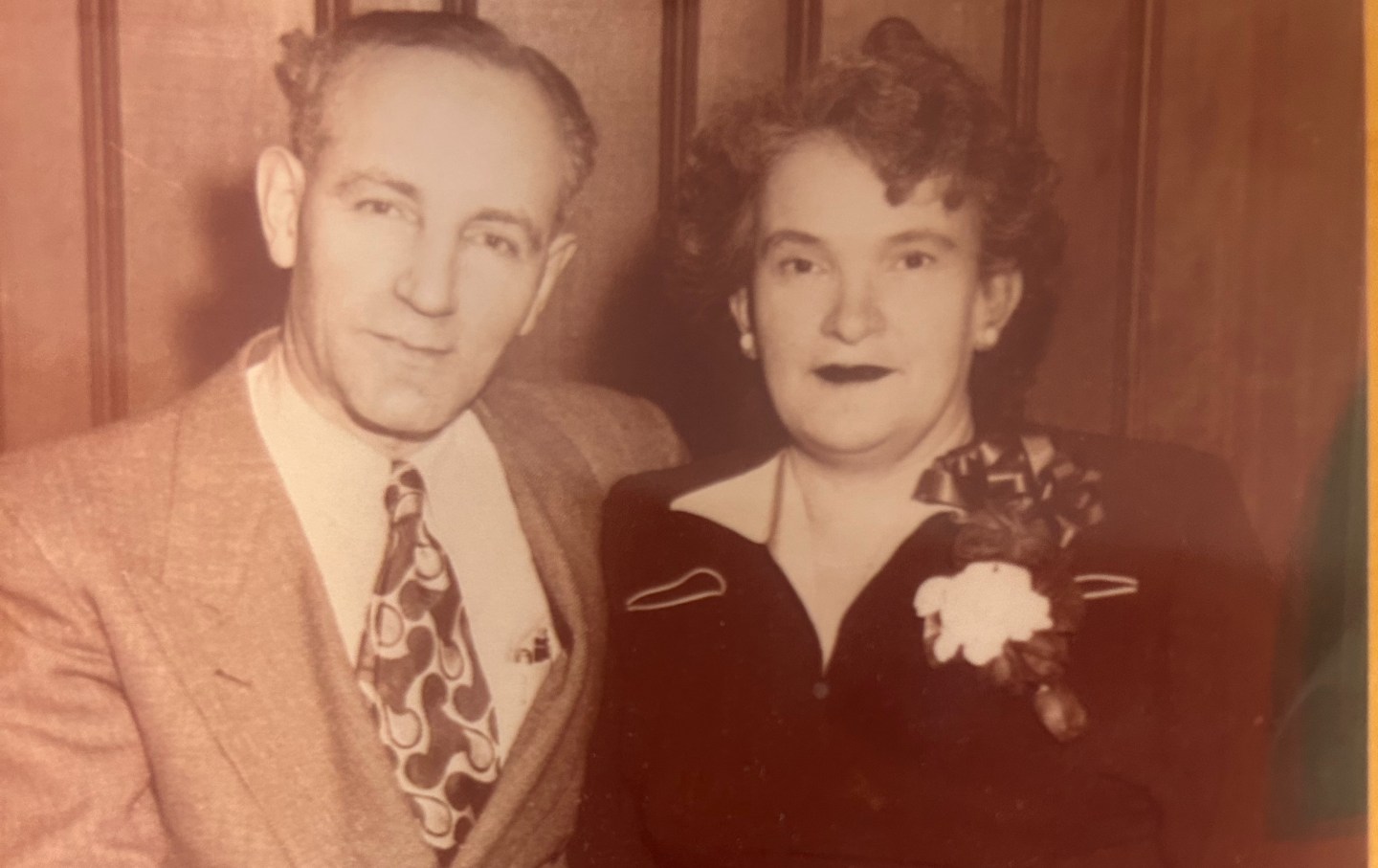
The Supreme Court v. My Mother The Supreme Court v. My Mother
After my mother escaped the Holocaust, she broke the law to save her family. Her immigration story is more pertinent today than ever before.
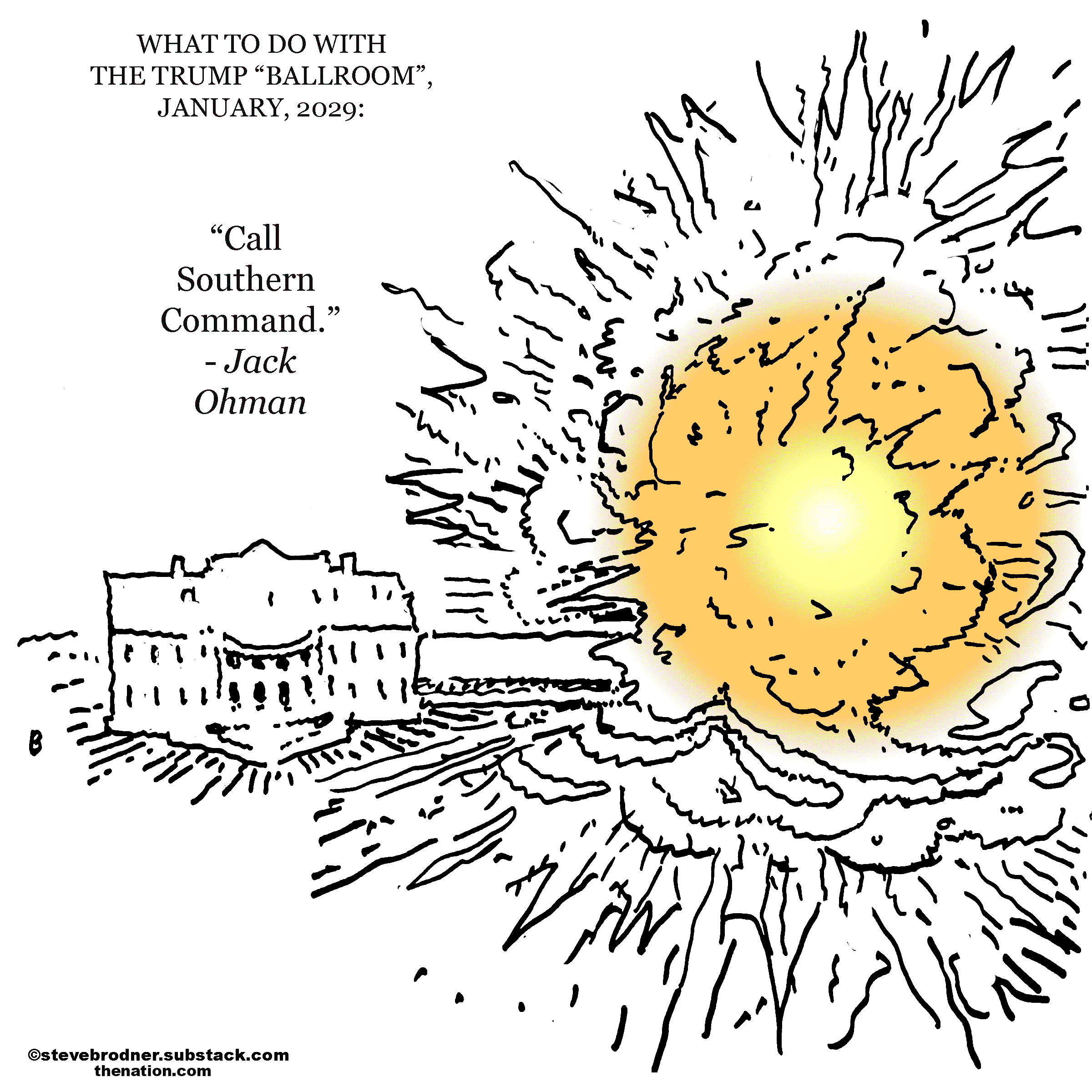
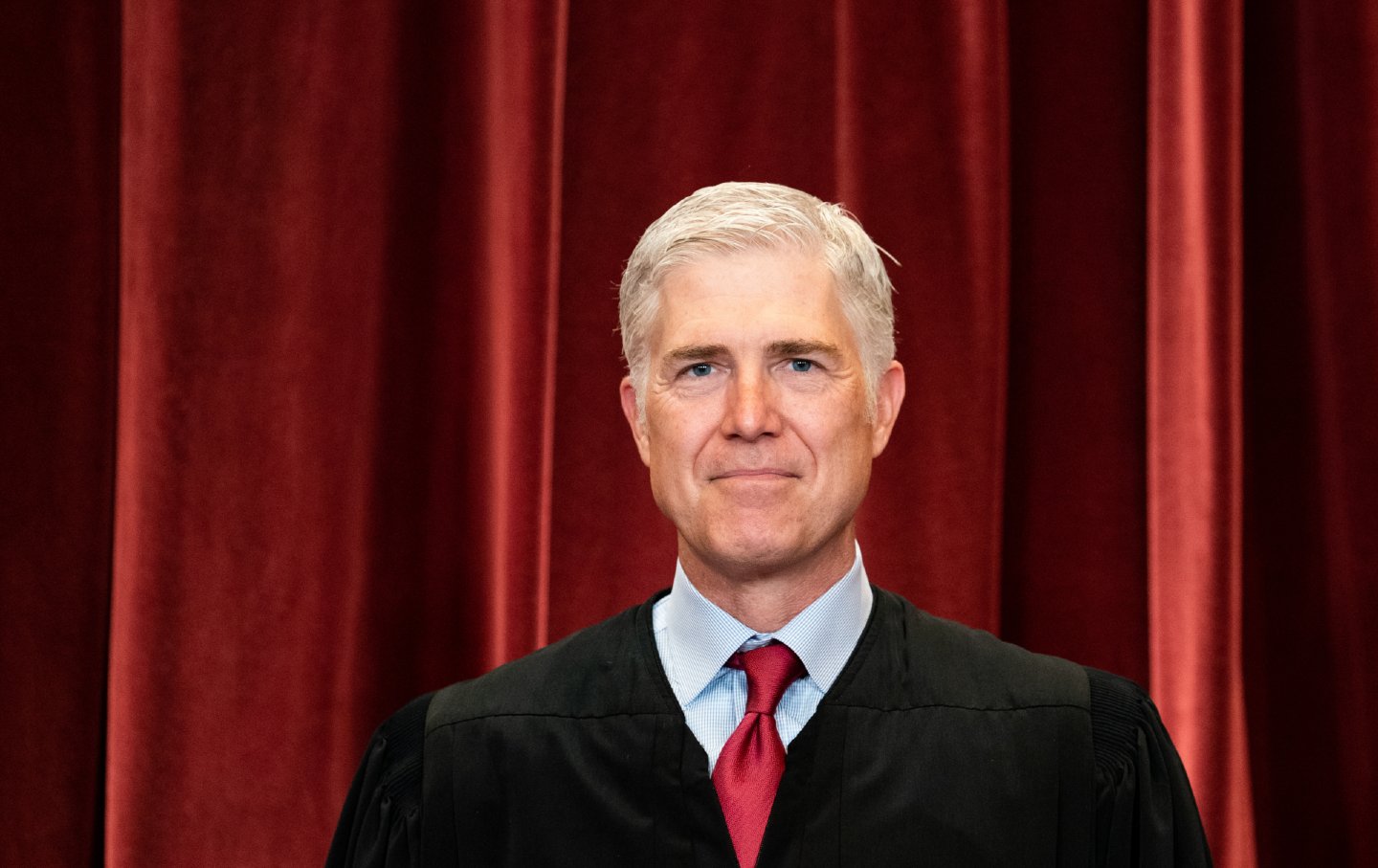
The Supreme Court Has a Serial Killer Problem The Supreme Court Has a Serial Killer Problem
In this week's Elie v. U.S., The Nation’s justice correspondent recaps a major death penalty case that came before the high court as well as the shenanigans of a man who’s angling...
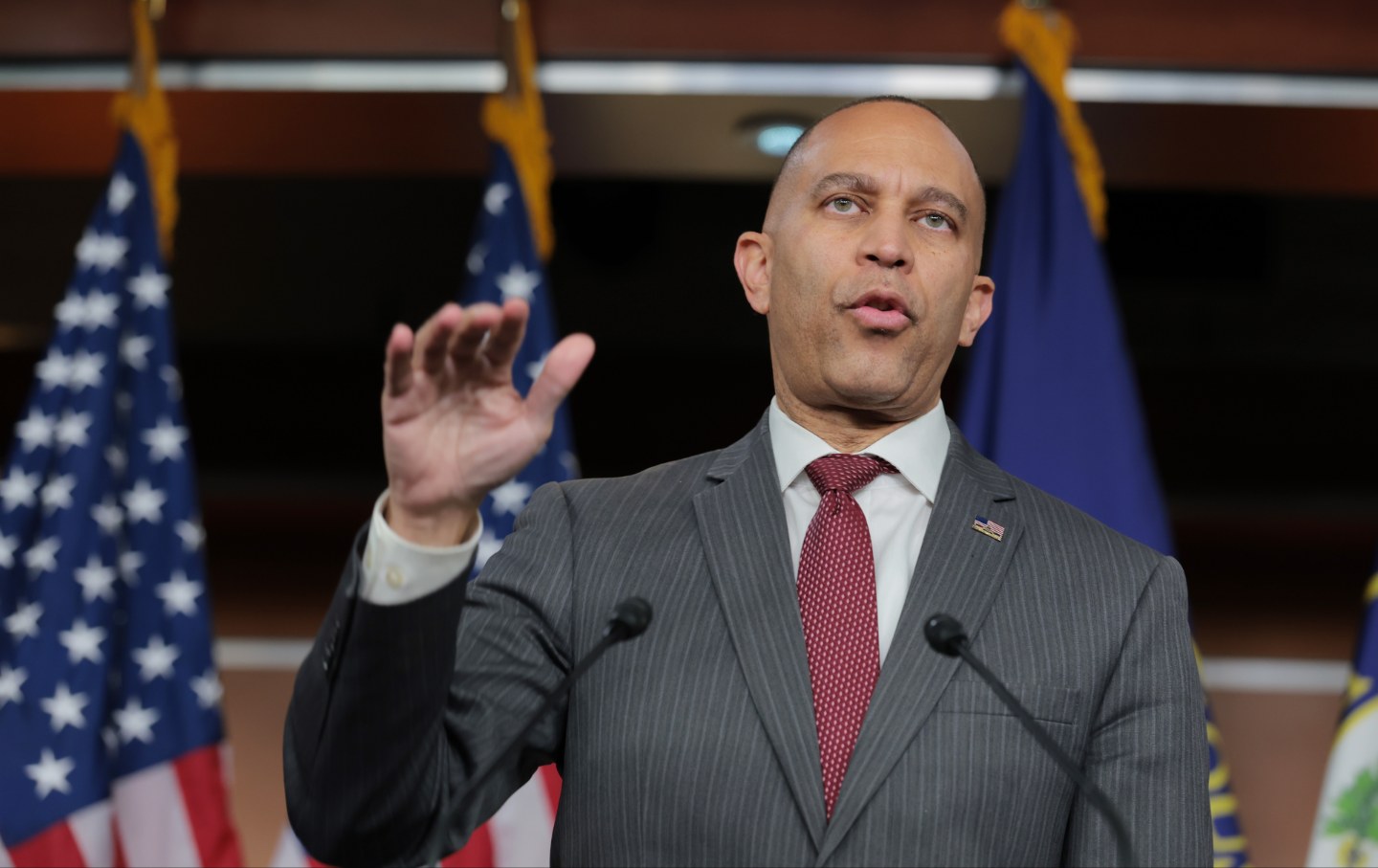
Corporate Democrats Are Foolishly Surrendering the AI Fight Corporate Democrats Are Foolishly Surrendering the AI Fight
Voters want the party to get tough on the industry. But Democratic leaders are following the money instead.
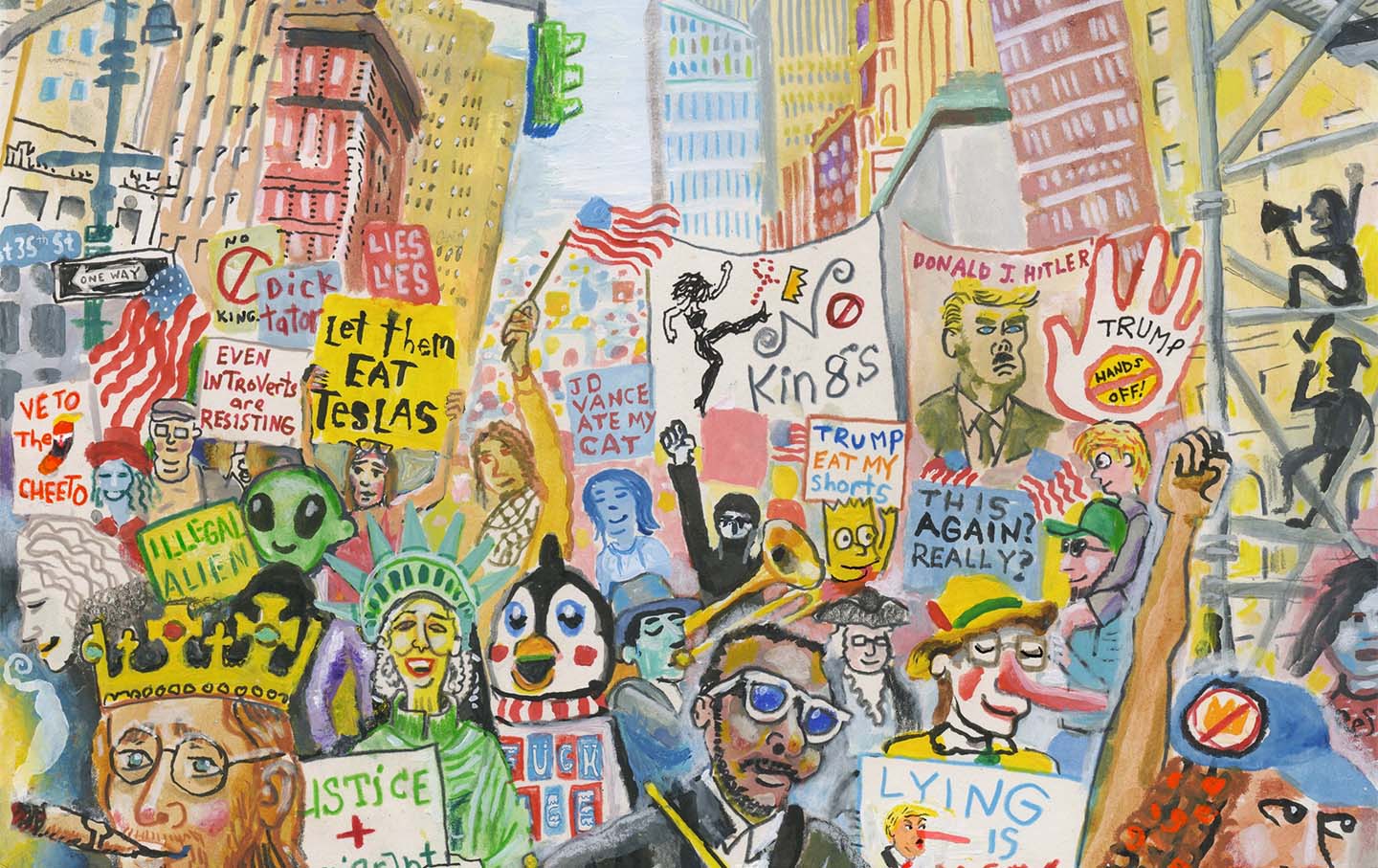
Marching Against a Corrupt Regime Marching Against a Corrupt Regime
People taking to the streets for democracy.

Keeping the Police Out of Pregnancy Care Keeping the Police Out of Pregnancy Care
We must be vigilant in keeping law enforcement out of exam rooms.


